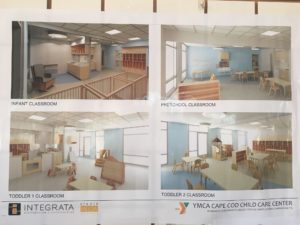Poised to “meet the challenge of the new downtown,” as YWCA Central Massachusetts President Roberta Brien announced, the all women-led construction team for the YWCA’s $24 million renovation broke ground Thursday morning.
The ceremony, attended by some 50 people, was held inside the YWCA’s gymnasium, because of frigid temperatures. Thirteen project and organization executives and contributors dug shovels into a large sandbox as cameras clicked.
The construction project at 1 Salem Square features building system upgrades, a new two-floor early education and care center, expanded transitional housing units, increased space for domestic violence services, reconfigured wellness and health areas and overall site enhancement, including a shared play area with Worcester Public Library.
YWCA’s $7.5 million capital campaign has already received $5.25 million in pledges, said YWCA President-elect Christienne Bik.
The state has committed $3.6 million in bond funds.
Included in that, the YWCA received a $1 million Early Education and Out of School Time capital improvement grant in December through the Department of Early Education and Care, one of six grant recipients to receive the largest investment the state has made in child care facilities, said Early Education and Care Commissioner, Samantha Aigner-Treworgy.
What makes the project unusual is that its field management and supporting staff teams are all women.
“We knew that their (YWCA’s) mission was empowering women,” said Jody Staruk, project executive for Consigli Construction, the project’s construction contractor.
When Staruk was approached to arrange a team, she said, “I had a significant pool of women to pull from.”
Women conduct the estimates, preconstruction management, virtual design and construction modeling, and superintendent and engineer positions in the field, Staruk said.
While women have worked on numerous separate teams, to pull them together on one project is a first for Consigli.
The owner’s project manager, Pinck & Co., an Anser Advisory company, and architects Fennick McCredie Architecture Ltd. are also part of the women-led team.
“When we sit in a meeting, it’s a dozen women in the room, solving world problems and getting work done,” Staruk said.
She called the process, “collaborative and creative.”
Women aren’t just involved in leading the project. Some women working on site will have come through the Worcester Jobs Fund, a training program for low-income residents.
“Because the percent of women working in construction is so low, a lot of women don’t think of construction,” despite the high pay, said Kelsey Lamoureux, director or the Worcester Jobs Fund. The program is housed at MassHire’s Central Region workforce board.
She said that nationally, 3% of workers on construction sites are women. In Massachusetts, it’s closer to 8% to 9%, with union efforts helping to push the numbers.
Women make up about half the training program in Worcester.
Lamoureux said she was looking for more women interested in construction for the next training program, which begins at the end of February.
Construction started last week and is expected to finish by the end of the year.
SourceTelegram





